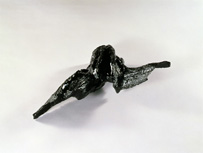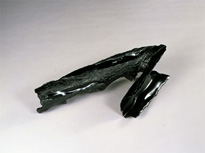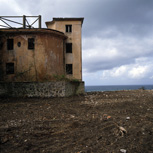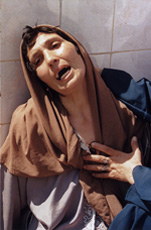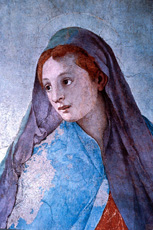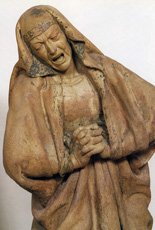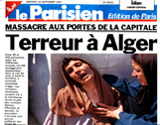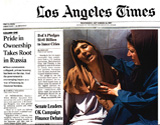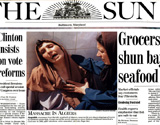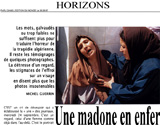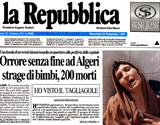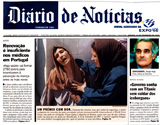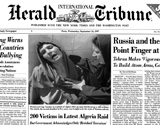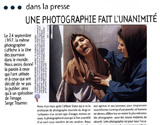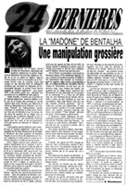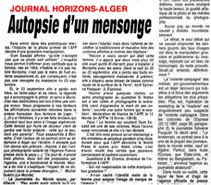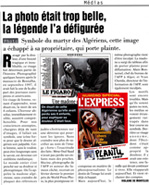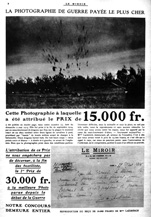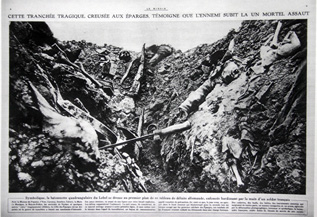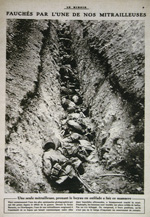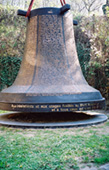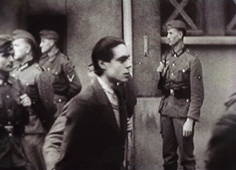Archéologie de l'architecture, de l'enfance, de l'histoire, du corps, des temps
1998 - 2005
Lamento
Lamento est un recueil de cinq textes tirés de l'ouvrage du même nom, édité par le Musée d'Art Moderne Grand-Duc Jean, (Mudam Luxembourg), à l'occasion de l'acquisition du Musée des trois sculptures de Pascal Convert autour de la question de la photographie de presse.
"Construire la durée" / "Constructing duration" / "Die Konstruktion der dauer" Georges Didi-Huberman
"Pascal Convert ou comment se dépêtrer du réel" / "Pascal Convert or how to get free of the real" /
"Pascal Convert oder wie man sich von der wirklichkeit befreit" Catherine Millet
"Images passages" / "Passageway images" / "Durchgangsbilder" Pascal Convert
"L'orphelinat des images" / "The orphanage of images" / "Das wisenhaus der bilder" Bernard Stiegler
"In Praise of Aeroliths", by Philippe Dagen
No doubt because I am writing these lines near the North Sea, in a landscape of dunes and overturned blockhouses, when I think of Convert's work, I think of his archaeological practices. By analogy, that is: what he drew on the Basque coast were not plans of geometrical concrete fortifications, but of exotic and eclectic villas. The blockhouses were destroyed by their own weight: too heavy for the hillocks of sand that were supposed to support them, they slid, the bases broke up, and some of them fell to the bottom of the slopes and are now no more than Cubist fragments sticking out of the sand or sea. Convert's villas were threatened then destroyed by erosion, the crumbling of the cliffs, the frittering of the earth by the ocean. These histories resemble each other only remotely. Except that both are stories about time, stories of destruction. And, consequently, stories of memory, of vestiges and exhumations - as are Convert's works, as much the wax sculptures as the phantoms of villas traced on the cliffs, the imprints of his body or the roots of trees.
By a simplification that, like others, is open to criticism, one could say that each of his works corresponds to an equation with three unknowns, to a formula in which three forces clash or combine: the force that builds, a natural or a collective force sustained by one or several machines; the force that destroys, in most cases a blind force that one could consider as natural, whether the nature in question is that of objects - Nature with a capital N - or that of human beings and their systems; and the dogged, feeble force of human will, of the artist, who refuses to be submerged by any of these powers, who refuses to be just "pure" production or "simple" nature.
Each of these words calls for elucidation, which I will endeavour to provide as best I can, bearing in mind that there is nothing neutral about such an attempt at commentary and that its author plays a considerable role in it. For if he writes with a mind to the artist's works and what he knows about the artist, he also and to the same degree writes with what he himself is and knows about it, or does not know.
What are these wax sculptures that Convert conceived and made several years ago now? Originally, they were images, photographs or a still from a filmed report. The word"image" cannot in itself be considered sufficient, especially since nowadays it is made to serve all kinds of discourses, and even more so because the "images" that Convert works with are not only or simply visual representations of given moments of contemporary history.
They have their own history, an origin, a specific definition, because they belong to a society of images - our society, which we cannot understand by comparing it to any other, and especially not to ancient societies, whose representations we call paintings or sculptures.
To limit oneself to what the eye sees would be to blanket out the conditions and contexts, to hastily adopt the suggestions implicit in the titles unofficially given to these photos, Pieta and Madonna, which fit them into a Christian iconography going back many centuries. In formal terms, that would be apt, certainly. But these names imply a comparative approach which if we are not careful, might lead us to think that because they are, respectively, a Pieta and a Madonna, these representations are "like" the Pietas and Madonnas of art history, like a Pontormo or a Caravaggio, say. Which they are not. A Pontormo or a Caravaggio is, by definition, immediately and undoubtedly considered in terms of a work of art, as a fresco or oil on canvas painted for the collection of a patron of the arts or for the wall of a chapel. It was, at the moment of its execution, subject to two different judgements, concerning its religious orthodoxy and its artistic excellence. The latter can be determined according to many contradictory or complementary criteria, but these criteria are known to those who form the community of art connoisseurs.
Merillon's and Hocine's photos are by what we might call their professional definition, items of information made to be disseminated as immediately and extensively as possible. They are subject to direct political judgement - the appropriateness or not of their publication, as decided by the powers that be or the censor, and to indirect political judgement, tinged with morality, by readers and the emotion inspired in them by these works, and also to judgement in and by the media - the prizes awarded to the authors of these photos according to their effectiveness and impact. But, at the beginning of their existence at least, they are not considered to be works of art, if by that we understand objects created within a system of education, reward and reputation of the kind that first developed during the Renaissance.
This Pieta and this Madonna are not unique masterpieces, but images reproduced a thousand times over, along with many others at the same moment. Uniqueness is the founding principle of the Pontormo or Caravaggio - the uniqueness of a precious autographic object. Multiplication is the functional principle of the Merillon and Hocine - and, already, just in using this expression, we sense that it is not appropriate, that we are not in the habit of talking about photographs in the same kind oflanguage as we use for painting. It is, naturally, a matter of reproducibility.
Now, this reproducibility cannot be u.nderstood outside the industrial system of communication, of which it is one of the characteristics and requirements. Things must circulate. (This could never been expected of a canvas by Caravaggio, not to mention a fresco: they did not have to be in circulation; anyone who wanted to see them had to go to them or make do with engravings which, however skilfully made, can never claim to be more than second best, or a record for teaching purposes. Merillon's Pieta, Hocine's Madonna and the sequence showing Abdallah's death have been seen on the covers and insides of magazines, on TV shows and repeats and excerpts. They have lived according to the usual regime of new images, the system of machines and quantity: layouts and dummies, printers, newspapers, networks. And if the question of authenticity has been raised in their regard - and it was, violently, for Hocine - this was not in order to ensure that the name of the photographer was correct, but to ask if the image had not been fabricated, if it had not broken the rules of sincere photojournalism, which is supposed to show what really happened in a given place at a given time.
This question of the subject's factual authenticity, which would be absurd in the case of a painting (Caravaggio did not need to prove that the conversion of Saint Paul really happened), is itself inseparable from the mechanical nature of these representations. Might the still or film camera have been used to convey events that did not actually happen? Was the process misused - was there trickery, artifice or manipulation? (This last word is very interesting in itself: to manipulate, that is to say, act with the hand, is now synonymous with deceit, and the word machination, which would be more apt here, is going out of use, as if it were somehow clear that the hand was on the side of falsehood and the machine on that of truth, particularly where images are concerned.) We thus have the association, if not the direct linkage, of several notions: the factual authenticity of the original mechanical representation; the mechanical multiplication of the image and its immediate public efficacy. In contrast, the traditional system of painting was based on the autographic nature of the object, its precious uniqueness and the slowness of its dissemination.
This can also be couched in Duchamp's vocabulary: modern exotericism versus the esotericism of the past. Exotericism cannot be distinguished from what has been referred to here as the industrial regime of representation.
(At this stage of the analysis, an observation comes to mind, of a biographical nature. Convert is one of the living French artists who knows this regime most intimately. He is familiar with how a television image is made and how its destiny is decided, with how a photograph is sold, or not, with authorial rights, with the administration and accounting of information. Talking with him, you can sometimes feel that you haven't seen or understood a thing about the media treatment of some recent event, that you were just an absentminded and imprudent viewer who failed to really look, compare and think hard enough about what you saw in the press or on TV. Convert knows all about the mechanics of images, which he understands with the discreet savoir - faire of the connoisseur. You need only see him in the role of reporter -filming an official ceremony, for example, or doing an interview, to realise that his approach is based on a practical and theoretical knowledge of this system. Another clue, of another kind, provides further confirmation, if that were required: Convert never uses those sweeping, definitive formulae branded by those who only dabble at distance. For example, he never talks about the "society of the spectacle".)
So, mass-produced images, series of images. Production being the dominant word here. If circulation is imperative, then production is vital. To that end there are production companies, units and specialists. There are also "housing units", "big outfits" and specialists in everything, from marketing to formatting, from advertising to "events management". There is no need to labour the point: it is hard to imagine a reader who has not at the very least noticed the fact that contemporary society is obsessed with the making and consumption of all kinds of articles, which are of course called "products". A film and a book are products in the same way as a car and telephone are. This fascination with products goes hand in hand with the fascination with profit. There is surely no need to repeat this after all those excellent authors whose excellence has not for one moment endangered the world that they have described and decried. The "Kosovo Pieta", the "Madonna of Bentalha'', the death of a Palestinian child - there is nothing to prevent us from thinking of these, too, as products, and even as "loss leaders", to be put on the cover of a book, or to whet the appetite for the television news like an aperitif before a meal. Do these comparisons disgust you? Well, don't blame the author, blame the way the world has been going these last few decades - a century's worth it will be, in fact, by the time we commemorate the hundredth anniversary of the First World War. That conflict played a key role: it brought both the industrialisation of slaughter and the constitution of a democratic industry of news images that exploited the sensational, the fearsome and the morbid just as effectively as we do today. Having leafed through a collection of issues of Le Miroir published between 1914 and 1918 in Convert's company, I can confidently say that he knows exactly what happened at that time, and what new definition of the image appeared "thanks" to Verdun, the Somme and Ypres.
Now, Le Miroir: a weekly with lots of photographs and only communiques from the general staff by way of prose. Or Paris Match, another weekly based on the "shock of images" - the best images, the ones that hit hardest and lowest. And the TV news, on whatever channel, in whatever country: daily programmes. What determines these flows and this regular, repetitive rhythm? Habit, for a start. And after that, indifference and forgetfulness. Their images belong to ordinary time, to everyday time. They belong to it for at least two reasons: because they represent it- they are "current" events - and because they fo llow its rhythm. Daily images of each day. They don't fo llow on from one another. They don't accumulate. They replace each other. This replacing function is indeed essential. Between representations, competition and sensationalism, in accordance with an elementary rule: that the image with the most violent impact should win out against those whose effect is judged slightly less powerful, until it is itself supplanted by another, more powerful one. In Le Miroir, the stakes were immediately defined by the circumstances: that death in battle should be photographed in the most obvious and quickest way, at the moment of impact or explosion. That the camera should operate in phase with death. A competition was organised between soldiers as reporters on their own comrades' deaths, with big cash prizes for the most striking shot. Result: an accumulation of corpses, images that were more or less manipulated, culminating, in 1916, in the ultimate "advance": a German corpse and a French corpse head to toe in a crater - a fine photo for the front page.
Before that, there had been the half-charred, mutilated bodies of women raped in Serbia. Afterwards, sti ll in Le Miroir, the repetition of death and its repeated tropes: buried alive, blown apart and into a tree, a skull in the earth, bare bone under the uniform. A rhythm was soon established: every Sunday morning, some two-score images to replenish the visual fix of the previous Sunday. What applies to images of death also holds for images of sex, whose criteria were set by pornographic photography as early as the 1850s: the most complete visibi lity for the most obvious motif - in other words, a man at the very moment when a projectile is tearing open his breast or belly, or a woman at the moment of opening her legs in order to exhibit her sex. Variants are possible for certain types of clients, but the basic principle has remained unchanged.
At this point of our analysis, a rather stupid-sounding question comes to mind: given that since the Second Empire, as far as obsceni ty is concerned, and, for morbidity, since the First World War, the most literal images have existed and have been widely (and profitably) commercialised, why do people go on making so many more? For the same reason that a couple rarely limits its lovemaking to the one time, but does it again as often as desire impels. This propensity for repetition, which affects - affects, and even defines - ocular as much as sexual pleasure, we can call nature (not necessarily human nature). This repetition postulates that we "must" start again and, therefore, that what has been is much less important than what will happen, in the moment, even when it is one and the same object. The blissful return of the identical.
To put it differently, the regime of the contemporary image is, like that of ordinary sexualities, the regime of daily new beginnings, and therefore also of daily erasure. Except for this one detail, namely, that images are not only the instruments of an instantaneous and oblivious visual satisfaction. And yet, every day, new images of the new day are everywhere and, the following day, they are nothing, they have disappeared - except for those "eccentrics" who tirelessly cut out and record, fighting the amnesia that this system encourages -"unwittingly, perhaps", I was going to say, until I remembered the minutes of brain vacancy that it is television's role to produce - what other word? - and sell to advertisers.
(Here, once again, I take the liberty of a biographical digression. When doing research into the First World War some years ago, through a photojournalist friend - surely no coincidence, that - I made the acquaintance of the writer Yves Gibeau, who chose to live below the Chemin des Dames battlefield, not far from the ruins at Craonne. He used to go walking in the fields and woods collecting vestiges of battle - twisted rifle barrels, pierced helmets, the bases of shells. This was one of his everyday activities. Another was writing novels. There was a third, which we understood only after his death: Gibeau was a manic recorder, storing the TV news on hundreds of cassettes. He dated and amassed these cassettes, as he did books and the pathetic, rusting trophies of battle. The absurd activity of a solitary archivist. An activity that was absolutely logical and necessary: he was pitting his single strategy against the forgetting of the men shot in 1917, against the forgetting of the killers and the victims of the end of the twentieth century. He opposed ordinary time with modest, almost trivial means, yet means that were enough to keep him above that time - as in keeping one's head above water. Gibeau is now all but forgotten, which is what you might expect from a society that hates nothing more than those who nurse "bad" memories.)
Amnesia. Production and pleasure are fuelled by amnesia. Besides, the proliferation and constant consumption of images leads, in the short term, to the saturation of memory: there are too many of them, they are too di verse, they come and go too fast. How many are there in a single news programme, speeding past so as not to bore a viewer thought ready to change channel as soon as the grip on his attention weakens. And in a weekly? There is no time to question their nature, and it seems highly likely that many TV viewers would find it hard to recall which images from the previous night were reportage or documentary and which were fiction. Genres move together and eventually merge. A long ribbon streams past. The facts, their interpretations - no time to think about that. Chronological order fades, hierarchies of importance lost their authority long ago and the results of a football championship come before wars and revolutions in countries too distant for their disasters to interest us in Europe.
I emphasise these points in order to suggest that this regime of the image determines a very particular temporality: continuous, uniform and unnoticed. The temporality of the everyday, in other words, with no accidents or breaks. Like that of sex, as I have suggested. Or of food, in prosperous countries where there is nothing difficult about feeding oneself. This temporality is the temporality of regular erasure, which worries no one: it is "perfectly natural", just as it is natural that Friday's news should wipe away Thursday's, and that sediments are deposited and then covered by other layers on the bottom of rivers. That is the idea I wanted to get to. The mechanical image industry, this formidable and totally artificial system of production now functions in the same way as nature, in.the geological sense of the term. Just as only exceptional catastrophes - earthquakes and eruptions - have the power to modify the process of sedimentation and erosion, so only exceptional human catastrophes have the power to momentarily arrest the flow of producing and forgetting of everyday images. In addition, these tragedies need to be sufficiently close for the viewer to project onto them. If not, the worst misfortunes soon become simple photos, appreciated only for their visual and technical qualities.
Where does Convert stand, what does his work do with regard to this system? He does his best to stop the flow, to counter that slow, irreversible phenomenon, to use archaeology to refuse forgetting. He has, so to speak, never done anything else, and that is why I started by mentioning his strange curiosity for those abandoned villas on the Basque coast doomed to destruction by the eroding waves. The roots of those trees felled by shells, that tree petrified by nuclear radiation, these faces and bodies doomed to annihilation - he is doggedly intent on wresting them from their destiny. Like the men shot on Mont Valerien, like the resistants of the MOI, like all those whom indifference, laziness, cowardice and stupidity condemn without even noticing.
And, also, like those few images of grieving, which, had he not taken them up, would suffer a similar fate: they would disappear. Soon, no one would know what they show: a death in Kosovo or Bosnia, a woman crying in Algeria or Afghanistan, a child shot in Palestine or Chechnya - what does it matter, when one thing segues into, equates to and cancels another, and they're all forgotten anyway?
The importance is moral, and therefore political. The point, of course, being to tell apart killers and victims, the guilty and the innocent. The persecution suffered by Hocine for having taken his photo is highly revealing in this respect - but it informs us only about the situation in a country that is neither democratic, prosperous nor Western. In a prosperous, democratic country, the phenomenon works differently: by saturation, overproduction and repetition, which have been studied at great length. But, so far, without stating that these characteristics deeply affect what remains of political life and intelligence. The image everywhere and for everyone - the democracy of the image - is also the image for itself and for nothing. For no meaning, for no deduction. It passes, for the pleasure of passing. In opposition to that, Convert creates a particularly abrupt kind of freeze-frame in that he forces the distracted viewer to engage with both his head and his torso, confronted as he is with a wall and with statues. He cannot but come up against it and be hurt by it. Be silent or cry out, but not chatter. Stop short or turn back, but not dodge, brush past. Everything freezes: the visual flux, the rhythm of production/consumption/forgetting, the habit of fast pleasure to be repeated as soon as possible.
"Calm block down here fallen from an obscure disaster". Mallarme's line described poetry itself, its stupefying irruption in the humdrum routine of common language -"purifying the language of the tribe" - its power to shatter what it touches, its incomprehensible potency; but it is well suited to Convert's sculptures, as well, to their stupefying irruption amidst the banality of images, to their power of penetration, to their scandalous strangeness, like aeroliths.
Philippe Dagen
/ Accueil /
Biographie / Oeuvres / Expositions / Films / Thématiques / Documents
Textes - articles / Editions / Liens - contact / Au hazard

